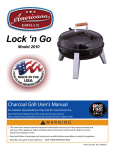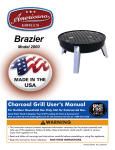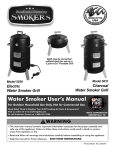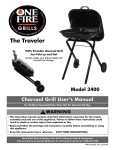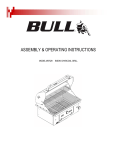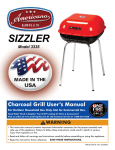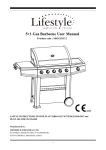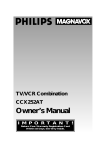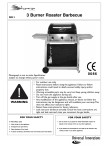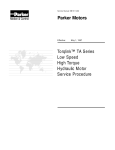Download Use and Care Manual
Transcript
SWINGER Model 4100 Charcoal Grill User’s Manual For Outdoor Household Use Only. Not for Commercial Use. Need Help? Need to Register Your Grill? Looking for Parts & Accessories? Visit us online at www.onefiregrills.com Or call Customer Service at 1-800-251-7558 ! WARNING • This instruction manual contains important information necessary for the proper assembly and safe use of this appliance. Failure to follow these instructions could result in death or serious injury from explosion or fire. • Read and follow all warnings and instructions carefully before assembling or using this appliance. • Keep this manual for future reference. SAVE THESE INSTRUCTIONS. P/N 03.6632.00 Rev. 20130522 2 ! DANGE R CARBON MONOXIDE HAZARD This appliance can produce carbon monoxide, an odorless toxic gas. Using it in an enclosed space can kill you. Never use this appliance in an enclosed space, such as a camper, tent, car, or home. This appliance is not intended for and should never be used as a heater. Meco Corporation strives to be a quality supplier of consumer products. If we omitted any parts needed for assembly, or you need troubleshooting information, please contact us using our toll free number or visit our website. It is important to register your grill and retain your receipt. 1-800-251-7558 8 am - 4:30 pm E.S.T. Monday - Friday 1-423-639-1171 (Telephone) 1-423-639-2570 (Fax) www.onefiregrills.com ! Consumer Service Department MECO CORPORATION 1500 Industrial Road Greeneville, TN 37745 USA WARNING To reduce the risk of serious bodily injury or death: · Never use a barbecue grill unless all parts of the unit are firmly in place and the grill is stable. · Never use gasoline, kerosene, alcohol or other volatile fluids as a starter. They can explode. · Do not use charcoal grill as a space heater. · Do not use aerosols or store flammable liquids or materials near this charcoal grill. Cap lighter fluid immediately and place a safe distance from the grill. · Instant light briquettes already have the starter blended in. Do not use lighter fluid, an electric starter, solid, or metal chimney starters. · Do not add more instant light briquettes once the fire has been lit. To avoid flame-ups, unpleasant fumes and odors, add regular charcoal briquettes if needed. · Once the barbecue grill has been lit, do not touch the charcoal briquettes/wood chunks to see if they are hot. · Never add lighter fluid to already hot or warm coals. · Do not close Hood on flaming charcoal. If closed and re-opened, the flames could leap out and burn. · Do not wear loose clothing (example: hanging shirt tails, clothing with frills, etc.) around a charcoal grill while in use or hot. · Do not lean your body over the charcoal grill when lighting it, while it is hot or is in use. · Do not touch hot surfaces. Use heat resistant gloves, long-handled tongs, or barbecue mitts at all times since the grill will become very hot. · Do not move a charcoal grill when in use or hot. · Do not allow children to operate or play near a charcoal grill. Keep animals and bystanders out of the grill area. Do not leave grill unattended. · Allow grill to cool before handling parts or cleaning. · To avoid a fire, allow coals to burn out completely and let the ashes cool for 48 hours before disposing of them. · Do not attempt to extinguish a grease fire with water or other liquids. Have an ABC fire extinguisher nearby. · Always have an ABC fire extinguisher, baking soda, a bucket of sand or a garden hose ready in case of an uncontrolled fire. WARNING: Combustion by-products produced when using this product contain chemicals known to the State of California to cause cancer, birth defects, or other reproductive harm. This product contains chemicals known to the State of California to cause cancer and/or birth defects or other reproductive harm. 3 Preparation for Assembly TOOLS NEEDED: Phillips head Screwdriver and a 3/8” open end wrench or a pair of pliers. LAY OUT AND IDENTIFY ALL PARTS. DO NOT DISCARD CARTON OR PACKING UNTIL YOUR GRILL IS COMPLETELY ASSEMBLED. READ ALL ASSEMBLY AND SAFETY INSTRUCTIONS IN THE OWNER’S MANUAL BEFORE YOU START. The extra holes in the side of the bowl are for mounting convenient accessories (side tables and rotisserie). For easier set-up, follow instructions of each step in the order they are written as you look at the diagrams. Part# Description Quantity 1 Owners Manual 1 2 Front Leg 1 3 Wheel Leg 1 4 Bowl 1 5 Hood 1 6 Handle Spacer 2 7 Hood Handle 1 8 Slide Vent 2 9 Control Label 1 10 Control Bracket 1 11 Hood Handle 1 12 Hood Vent 1 13 Leg Cap 2 14 Wheel 2 15 Axle 2 16 Cotter Pin 2 17 Hinge, Short 2 18 Hinge, Long 2 19 Knob, Adjusting Rod 2 20 Left Adjusting Rod 1 21 Right Adjusting Rod 1 22 Screw, #8 x 5/8” 2 23 Acorn Locknut 13 24 Square Nut 10 25 Screw #10 x 1 3/4” 2 26 Bolt, 10-24 x 1/2” 17 27 Bolt, 10-24 x 1 1/4” 6 28 Ash Pan 1 29 Cooking Grid 1 22 26 23 2 4 3 5 Note: The Wheel Leg has hole at the bottom of each end and is shorter than Front Leg 6 9 8 7 14 17 16 15 18 13 12 11 10 19 20 21 20 24 27 28 29 If you need replacement parts, refer to the Parts Illustrations to find the exact parts you need. If you have any questions or need help, contact Customer Service at 1-800-251-7558 or go to www.onefiregrills.com. Be sure to have the grill model number. If you need a replacement part under warranty, a proof of purchase will be necessary. You will be asked to forward your proof of purchase via e-mail or to fax your proof of purchase to 423-639-2570 and reference your model number. It is important to register your grill and retain your receipt. ! CAUTION To reduce the risk of a cut, pinching or other bodily injury: Wear protective gloves when handling parts that could have sharp edges, keep hands and fingers away from hinges and pivot points. Read and follow these instructions to set up your grill. 4 Step 1 Bowl / Slide Vent Assembly Attach Slide Vent Covers to front and rear of Bowl. (FIG. 1) Insert 10-24x1/2” Bolts through inside of Bowl and attach Acorn Locknuts to Bolts from opposite side. Do not tighten completely so Vent Covers will slide freely from right to left. Attach Control Bracket to front of Bowl with four 10-24x1/2” Bolts through inside of Bowl. Attach four 10-24 Square Nuts from opposite side. Peel backing strip slowly from Control Label and apply to Control Bracket. Center label on the bracket and align High, Med and Low indicators with the notches. 10-24 x 1/2” Bolt Hood Handle Hood Vent Cover Handle Spacer FIG. 2 #10 x 1 3/4” Screw Slide Vent Cover FIG. 1 10-24 x 1/2” Bolt Control Label Acorn Locknut Control Bracket Hinge holes to rear of bowl Square Nut Step 2 Hood Assembly Assemble Hood Handle and Spacers to Hood with two #10 x 1 3/4” Screws from inside of Hood. (FIG. 2) Place the wide end of spacers toward the Hood surface. Tighten completely. Attach Hood Vent Cover on top of Hood with one 10-24 x 1/2” Bolt and Acorn Locknut. Do not tighten completely. Acorn Locknut FIG. 3 Long Hinge Step 3 Short Hinge Hinge Assembly Attach Long and Short Hinges to Hood and Bowl. (FIG. 3) Insert eight 10-24x1/2” Bolts through Hinge holes from inside Hood and Bowl. Attach Acorn Locknuts to Bolts from the outside. Do not install Bolts and Nuts the opposite way. Do not tighten completely so Hood will raise and lower freely. Acorn Locknut 10-24 x 1/2” Bolt FIG. 4 FIG. 4A Step 4 Cotter Pin Axle Front Leg Assembly (FIG. 4A) Install Leg Caps on ends of Front Leg Note: The Front Leg does not have holes at the end near the Leg Caps. Wheel Leg Assembly Insert an Axle through the center hole on the recessed side of the Wheel. (The opposite side that is placed against the leg tube has a raised cone shaped center.) Insert the end of the axle, that extends through the wheel, through the hole in the end of the Leg Tube. Fasten in place by inserting the Cotter Pin through the hole in the end of the Axle (FIG. 4B). 5 Step 5 FIG. 5 Bowl / Leg Assembly Place Hood and Bowl Assembly on a protective pad or the carton cut out flat on the floor. (FIG. 5) Lay Hood and Bowl Assembly on its back side with Hood resting toward the floor. Align the leg holes with holes in bottom of bowl and install six 10-24 x 1 1/4” Bolts from inside the bowl through the legs. Attach six Square Nuts and tighten. Square Nut Step 6 10-24 x 1 1/4” Bolt Adjusting Rod Assembly Insert the end of the Left Hand Adjusting Rod into the hole underneath the Slide Vent on the left side of Bowl. (FIG. 6A) Push and twist the Rod through the hole until the end reaches the hole at the rear of the Bowl. (FIG. 6B) Fit the Rod into one of the notches on the left side of the Control Bracket and pull on the back end of the Rod to let the end spring into a rear hole. (FIG. 6C) Make sure the part of the rod inside the Bowl lays to the left when in its lowest position. Repeat for the Right Hand Adjusting Rod. Check to be sure you can position each Rod into each of the three notches in the Control Bracket. FIG. 6A FIG. 6B INSERT UP TO THIS POINT Left Adjusting Rod FIG. 7 Right Adjusting Rod Step 7 Knob and Bowl Handle Assembly Position the holes in the Adjusting Rod Knobs over the ends of the Rods. (FIG. 7) Drive the Knobs on with a rubber or wooden mallet. If using a hammer, use the handle end to drive the knobs on instead of the metal head. Adjusting Rod Knobs #8 x 5/8” Screw Bowl Handle Position the Bowl Handle inside the ends of the Control Bracket. Insert two #8 x 5/8” Screws through the side holes in the Bracket and into the Handle. Tighten both screws securely. Step 8 Fire Grate / Ash Pan - Cooking Grid Assembly Install the Fire Grate/Ash Pan in bottom of Bowl. Place the Cooking Grid on top of Grid Adjusting Rods. (FIG. 8) Make sure Grid center wires underneath are oriented side to side for easy glide height adjustment. (See Arrows) Cooking Grate Fire Grate / Ashpan FIG. 8 FIG. 6C 6 USING CHARCOAL To reduce the risk of serious injury or death from explosion or fire: • Be careful when burning charcoal to avoid getting burned from flame, heat or hot coals. • Be aware of the wind blown sparks. • The use of alcohol, prescription or non-prescription drugs could impair the consumer’s ability to properly assemble or safely operate this appliance. SELECTING A LOCATION To reduce the risk of serious injury or death from explosion or fire: • Locate your grill an open area away from buildings, dry leaves, or brush, and at least 10 feet away from your house or building. • Always make sure the grill is on a level, stable surface and not tilted toward the front or back. • Do not use the grill in a garage, breezeway, carport, porch, high traffic area, on or under any surface that can catch fire. • Do not use a charcoal grill indoors, on recreational vehicles, or on boats. STARTING A FIRE To reduce the risk of serious injury or death from explosion or fire: • Make certain you leave the Hood all the way open until the flames have died down. • Should electrically operated starters be used, be sure they are properly grounded according to local codes. Electrical cords should be placed away from walkways or traffic areas. • Do not use lighter fluid, an electric fire starter solid, or chimney starters with instant light charcoal. This could cause flame-ups, unpleasant fumes and odors. • Use barbecue mitts and long handled tongs to spread out the hot charcoal. • If there is any type of fire that threatens either personal safety or property, call the fire department. COOKING ON YOUR GRILL • To reduce risk of burns from the hot air and steam trapped inside, open the Hood carefully when grill roasting. • Do not grasp the Cooking Grid with your hands while it is hot. Use barbecue mitts for handling. • If flare-ups occur, close the Vents for at least one minute to stop flare-up. Do not use water. END OF COOKING SESSION To reduce the risk of serious injury or death: • Allow the grill to cool completely before cleaning, transporting or storing. • Empty and clean the Fire Bowl after each cooking session so excessive grease and ashes do not accumulate. See Cleaning instructions on next page. • Store your charcoal grill in a cool dry place. • Do not store charcoal and lighter fluid indoors. • Store out of the reach of children. • Do not store additional charcoal and lighter fluid under or near the grill while it is hot. • To avoid a fire or explosion, do not store charcoal or lighter fluid near a heat source. • Always cap the lighter fluid when not in use. To reduce the risk of injury or parts falling out during transport: • Make sure legs are folded and locked and hood and bowl are latched securely. Starting a Fire For Grilling For Indirect Cooking 7 STARTING A CHARCOAL FIRE IN YOUR OneFire SWINGER GRILL STEP 1. Use a high quality hardwood charcoal to make sure you get a good fire. Charcoal briquettes made from maple, oak, birch or elm woods will burn clean with very little smoke and without unpleasant odors. STEP 2. Open the hood and all the vents. STEP 3. Remove the Cooking Grid. Line the bottom of the Bowl with heavy duty aluminum foil. STEP 4. Place about three pounds of charcoal (35-40 briquettes) in the bottom of the grill. STEP 5. Make a pyramid shaped stack near the front of the Bowl and pour on charcoal lighter fluid following the instructions on the container. Warning: Do not use lighter fluid if you are using instant light briquettes or an electric fire starter. STEP 6. Let the lighter fluid soak in for approximately one minute. STEP 7. Carefully light the charcoal and let it burn for 20 to 30 minutes or until it is covered with a light gray ash. NOTE: For a hot fire in a hurry, use a fan or a bellows to create extra air movement over the charcoal. Be careful not to blow the ashes out of the grill. STEP 8. Use long-handled tongs to arrange the charcoal in a checkerboard pattern. Leave about one-half inch of space between each piece of charcoal. This will help you to avoid flare-up from the meat drippings and will give you more even heat for grilling. COOKING ON YOUR OneFire SWINGER GRILL 1. Cooking on the Grids: You can adjust the cooking temperature of your grill in three ways. For SLOWER cooking, move both knobs towards the center of the grill to raise the cooking grid. For FASTER cooking, lower the cooking grid by pulling on both knobs and moving them to the outside. You can adjust both sides at the same time, or one at a time. By raising one side and lowering the other, you can cook rare meat and well done at the same time. Use the lowest position for searing steaks and hamburgers or when more heat is needed. Foods cook very fast at this position, so watch your food carefully. Raise the grid to the middle slot to finish cooking steaks and hamburgers. Start cooking with the grid in the middle position for meats, such as pork and chicken, that have to be cooked a long time. The top grid height is good for baking or warming breads, or any time your fire is very hot. 2. TILT-AWAY HOOD...Leave the hood open for “Texas Style” open air barbecuing. Close the hood for “Smoker” cooking or when you want to hold in all the heat. 3. ADJUSTABLE DRAFT...Leave the hood vent open for the most heat, close it to lower the heat. It takes a few minutes for the charcoal to react to the vent adjustment. 4. SMOKING...For true smoke flavor, use chips or chunks of wood from nut or fruit trees such as hickory, walnut, cherry or apple. Soak the chips in water overnight (or at least 2 hours before cooking) so they will not burn so quickly when you put them on the charcoal. After you get the fire started and charcoal spread out, scatter the soaked chips on top of the hot charcoal using tongs. Spray the Cooking Grid with cooking spray so food does not stick, then snap the Cooking Grid in place. CAUTION: Use long barbecue mitts to snap in the grid. Place the meat on the grid, close the hood, and adjust the vent for the desired heat. 5. FLARE-UPS...Close the vent for at least one minute to stop flare-ups. You do not have to use water. 6. PUTTING OUT THE CHARCOAL...Save your charcoal to use again by closing the hood and all vents. The charcoal will go out in a little while and the next time you cook, you will need to add less new charcoal. CARE OF YOUR OneFire SWINGER GRILL For easier cleaning and before each time you cook... line the bottom of the fire bowl with heavy duty or a double layer of aluminum foil. Make sure you leave all the vents uncovered. Ashes...Remove the ashes as soon as possible after each time you cook but wait until the charcoal has cooled. Pour out the ashes or wrap them in the aluminum foil from the bottom of the Bowl. Never put hot ashes in a garbage container. You can save any leftover charcoal for use next time you cook. Use a garden hose to wash out accumulated grease and ashes. Let the grill dry before closing. Cooking grid...Use a detergent and hot water solution just as you would for any cooking equipment. A stiff brush may be helpful in removing heavy grease deposits. Hood and Bowl...Dampen a cloth in hot water and a detergent solution. Then, wipe both the inside and outside of the hood and bowl. CAUTION: Be careful around sharp edges of the grill. Wipe all areas dry before storing. Note: Do not use oven cleaner or abrasive cleaner on your grill. This may cause damage to the paint finish. Storage...After you have cleaned your grill, store it in a clean, dry area. Leave all the vents open so moisture does not collect inside causing rust. If you store your grill outside, close the top vent to keep the rain out. If rust appears on your grill, clean and buff the affected area with steel wool. Touch up bare metal with a high heat paint specified for barbeque grills. Follow paint manufacturer’s instructions for use. 8








